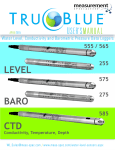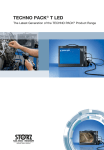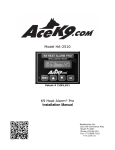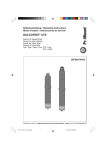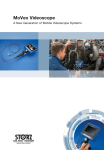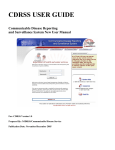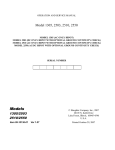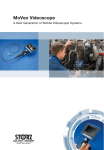Download TruBlue Data Loggers - Manual
Transcript
For U SER’S M A N U A L level and pressuretransducers 555/565 LEVEL 575 BARO 585 CTD www.TruBlueMonitor.com order online: www.Level and Pressure.com 1 8 0 0 7 4 5 8 0 0 8 A U G U S T 2012 • • • • TruBlueUser’sManual tableofcontents 1. introduction ........................................................................................................ 1 Thank You for Your Purchase .................................................................................................1 About Measurement Specialties/Pressure Systems...............................................................1 Website and E-Mail ..............................................................................................................1 Technical Support .................................................................................................................1 Ordering Products and Accessories .......................................................................................1 Manual Content Disclaimer ...................................................................................................1 2 . Tr u B l u e s e r i e s o v e r v i e w ......................................................................... 2 3 . u s i n g t h e Tr u W a r e s o f t w a r e p r o g r a m ........................................3 4 . c o n n e c t i o n s a n d f i e l d i n s t a l l a t i o n ...............................................5 Two Types of Field Cable ......................................................................................................5 Interface Cable Assembly......................................................................................................5 Suspension wire ..................................................................................................................5 Connecting the Transducer to the Field Cable........................................................................6 Connecting to a Computer or Other Device............................................................................7 Interface Cable Assembly..................................................................................................... 7 Suspension Wire.................................................................................................................. 8 Internal Clock Synchronization..............................................................................................8 General Field Installation......................................................................................................8 Cable Protection...................................................................................................................9 5. conductivity .......................................................................................................10 What is Conductivity?.........................................................................................................10 Types of Conductivity Measureme.......................................................................................10 Actual Conductivity.............................................................................................................10 Specific Conductivity...........................................................................................................10 Salinity...............................................................................................................................10 Calibrating the Conductivity Sensor.....................................................................................10 6 . m a i n t e n a n c e .......................................................................................................11 Cleaning Your Transducer..........................................................................................................................11 7 . t r o u b l e s h o o t i n g ..............................................................................................................12 8 . w a r r a n t y a n d p r o d u c t r e t u r n p r o c e d u r e s .................................16 Warranty.....................................................................................................................................................16 Merchandise Return Procedures................................................................................................................16 9 . a p p e n d i x A : Tr u B l u e c o n n e c t i o n d i a g r a m s .............................18 Appendix A: TruBlue Connection Diagrams...............................................................................................18 Figure A-1: Model 855...............................................................................................................................18 Figure A-2: Model 854...............................................................................................................................19 Figure A-3: Model 860...............................................................................................................................20 Figure A-4: Model 860-100........................................................................................................................21 Figure A-5: Model 851...............................................................................................................................22 Figure A-6: Model 852...............................................................................................................................22 1.Introduction : thank you for your purchase The TruBlue line of water level transducers offers accuracy, versatility and extensive features. You’ve made a commitment to quality. In return, we promise a high level of service and support to help you get the most from your investment in leading-edge environmental monitoring instrumentation. about pressure systems c h a p t e ro n e 1 September 2010, Measurement Specialties, Inc. (NASDAQ: MEAS), a global designer and manufacturer of sensors and sensor-based systems, announced the acquisition of Pressure Systems, Inc. (PSI). Measurement Specialties will continue to develop, manufacture and service highly accurate level measuring instruments for environmental applications and is commited to consistently meeting and exceeding customer’s expectations. website and e-mail You can visit our website at www.meas-spec.com for information on our latest product releases, application notes, product specifications and certifications, and IS control installation drawings. We welcome your questions and comments and strive to reply promptly. Please e-mail us at WL.sales@ meas-spec.com. INTRODUCTION technical support While this manual provides extensive guidance for everything from setup through maintenance, we understand that there’s nothing like getting an expert on the phone to provide quick answers and help address challenges for your particular application. If you have questions concerning any of our products, call (757) 766-1500 or 1-800-745-8008, extension 4398 Monday through Friday between 8:00 a.m. and 5:00 p.m. Eastern Standard Time. ordering products and accessories For your convenience, orders may be placed on-line by visiting our e-commerce website, www.LevelandPressure.com. You can also contact our Customer Service department at 1-800-745-8008 or contact your local representative. Expedited shipping is available. MANUAL CONTENT DISCLAIMER This user’s manual was prepared for the current firmware and software releases at the time of the manual publication. While this document is believed to be thoroughly reliable, Measurement Specialties assumes no liability for inaccuracies. Addenda will be distributed as deemed necessary. All computer programs supplied with your products are written and tested on available systems at the factory. Measurement Specialties assumes no liability for other computers, languages, or operating systems. We reserve the right to change the specifications without notice. Any questions regarding firmware upgrades may be addressed to Applications Engineering. Application software and transducer firmware revisions as well as manual addenda may be obtained from on www.meas-spec.com. 2.TruBlueseriesoverview TruBlue represents the leading edge of pressure sensing technology. Built with power conserving microcomputer circuitry and offering the highest level of functionity and accuracy available, the TruBlue series comprises four transducer models: model measuresandlogs... T R U B L U E 555 L E V E L Temperature & Level submersible? Yes c h a p t e rt wo T R U B L U E 565 L E V E L Temperature & Level - High Accuracy Yes T R U B L U E 575 B A R O Temperature & Barometric Pressure No T R U B L U E 585 CTD Conductivity, Temperature & Level Yes key features: 2 • User-friendly TruWare software included TRUBLUE SERIES OVERVIEW • New fully sealed design • 5-year permanent battery (at a 15-minute logging rate) • 8MB internal memory • Rugged 316 stainless steel with poly cable or titanium with ETFE cable for harsh environments for submersible devices • 2-year warranty against manufacturer defects • Level/barometric pressure accuracy of 0.1% of FS and high accuracy of ±0.1% reading • Vented or absolute reference • Calibration report included with each instrument when shipped • Easy set-up and data retrieval • Integrated temperature measurement up to ±0.2ºC accuracy • Field upgradeable firmware • Quick-disconnect cable assembly • Industry standard SDI-12 protocol • Optional RS-485 to SDI-12 converter for connectivity to 3rd party SDI-12 devices 3.usingtheTruWaresoftwareprogram Both powerful and user-friendly, TruWare is the software program designed specifically to manage TruBlue transducers and the data they collect. Used together, a TruBlue transducer and TruWare are ideal for monitoring groundwater and surface water levels inwells, open channels, lakes, streams and reservoirs as well as general c h a p t e rt h r e e watershed management. F I G U R E 1 : T H E T R U B L U E I N T E R F A C E 3 USING THE TRUWAREHE SOFTWARE With its highly visual interface and powerful features, features TruWare makes it easy to manage your TruBlue transducer. w i t h Tr u W a r e y o u c a n : • Make a direct connection between a PC or laptop and one or more transducers (fig. 2) • Program tests (customized data collection schedules) for connected transducers • Extract data from a previously initiated test c h a p t e rt h r e e 4 • View, save and export test data and real-time readings • View data as a table or dynamic, y , self-updating p g graph g p displaying p y g the parameters p of your choice • Check for and download firmware updates for hardware • Calibrate the conductivity sensor (if available) for monitoring the electrical FIGURE 3 ; C A L I B R A T I N G C O N D U C T I V I T Y S E N S O R conductance (fig. 3) USING THE TRUWAREHE SOFTWARE For detailed instructions on using TruWare, please see the TruWare User’s Manual that comes with the software and is also available at our website. 4.connectionsandfieldinstallation two types of field cable c h a p t e rf o u r There are two types of cable that may be used in deploying your TruBlue transducer— universal cable or suspension wire. Which you choose will depend on the transducer’s pressure format (absolute or vented gauge) and communications needs. THE INTERFACE CABLE UNIVERSALCABLE(model#853) A S S E M B LY 5 includes power and communications conductors as well as a reference pressure vent tube. It C O N N E C T I O N & F I E L D I N S TA L AT I O N should be used with all vented TruBlue transducers. It can also be used with absolute transducers in order to provide the ability to communicate with the transducer without extracting it from its measurement location. THE SUSPENSION WIRE SUSPENSIONWIRE(model#852) is a low-cost suspension solution intended for use only with absolute transducers. Since there is is no vent tube or desiccant filter, maintenance is minimal. On the other hand, the fact that there are no communications conductors in the cable means that, in order to communicate with the transducer, it will need to be removed from its measurement location. connecting the transducer to the field cable • Inspect the two O-rings (C) on the open (connecting) end of the transducer. Make sure they are clean and not damaged. (Figure 4.2) • Look inside the open (connecting) ends of the transducer and the cable to see how the two mate together. Note the two “keys” in the transducer and cable assemblies and c h a p t e rf o u r the fact that they are different sizes to ensure proper alignment. (Figure 4.1) F I G U R E 4 -1 : C A B L E M A T I N G K E Y A Figure 4.1: (A) Transducer/cable mating key and the open (connecting) 6 C O N N E C T I O N & F I E L D I N S TA L AT I O N B end of the cable assembly is also sometimes called the“thimble” (B). F I G 4.2: T R A N S D U C E R R I G H T +CABLEASSEMBLYLEFT C • Gently Genn tl tlyy insert i n sert inse rt the t he h e transducer t ra rans nsdduce d u cerr housing h o usiing hous i n g into i n to the t he h e cable c ab abl b le l e thimble t hi mb mbl b le l e (knurled ( knur k n urlled l e d assembly). asse as se mb mbl b ly) l y ) . Hold H old the transducer assembly in one hand and the cable in the other near the thimble. • While applying slight pressure to push the two parts together, slowly rotate the transducer assembly in the thimble until the keys align. When that happens the housing will slip into the thimble assembly an additional inch and you will no longer be able to rotate the transducer while holding the cable. • Now that the keys are aligned and seated, grasp the transducer in one hand and the knurled thimble in the other. • While applying slight pressure to push the two parts together, screw the thimble onto the transducer housing. Continue threading the parts together until they are fully mated, leaving no visible gap where the thimble meets the transducer housing. connecting to a computer or other device c h a p t e rf o u r INTERFACE CABLE A S S E M B L Y The up-end of the 853 Interface Cable assembly provides simple yet elegant TruBlue connection to the above-ground environment. The assembly incorporates an innovative vent filter that provides lifetime moisture protection for vented gage transducers. A GORE-TEX® plug prevents water droplets from entering 7 the filter while allowing air to pass freely C O N N E C T I O N & F I E L D I N S TA L AT I O N filter, housed in corrosion-resistant grade to the internal silica gel desiccant. The 316 stainless steel, also provides surge protection and features a compact electrical connector. The 853 Universal Cable connects to the computer via a communications cable. For this there are two options: 1. T H E 8 5 5 C A B L E An all-in-one adapter enabling connection to a computer, modem or PDA. It features built-in conversion to RS-232 and USB as well as a DC input connector. 2.THE 854 CABLE An an economic alternate for permanent installations. The cable incorporates a DC input connector but requires external converters to connect to an RS-232 (serial) port or USB port. SUSPENSION W I R E Absolute transducers typically use the 852 Suspension Wire when deployed (unless the ability to communicate without extraction is desired, in which case a universal cable can be used.) The 853 Universal Cable is still needed to extract data, in addition to the 855 Universal Adapter. Connecting the 851 Communication Cable to a computer requires an adapter. There are three adapters to choose from: 1. The 860 Adapter connects to an RS-232 serial port 2. The 860-100 Adapter connects to an SDI-12 port c h a p t e rf o u r 3. The 860-200 connects to a USB port TI P : Because of your TruBlue transducer’s sealed design, which improves durability by eliminating moisture intrusion, the unit’s batteries cannot be removed, replaced or recharged. The two 3-volt lithium ion batteries that are built into the 8 unit will last five years when logging every 15 minutes, after which an external power source can be used through the use of an external battery connector. C O N N E C T I O N & F I E L D I N S TA L AT I O N internal clock synchronization When received from the factory, your TruBlue transducer’s internal calendar/clock will be set to Eastern Standard Time. The internal clock can be quickly and easily synchronized to your local clock and time zone using TruWare. Please refer to the TruWare User’s Manual for details. general field installation The TruBlue is calibrated for operation in a vertical, upright position with the cable extending up. Although it may be operated in any orientation, anything other than this vertical position will result in a slight zero offset in the measured data. If the transducer will be operated in a known, non-vertical orientation this zero offset error may be easily calibrated out. cable protection Cable damage is one of the most common causes of transducer failure. Here are a few precautions you should take in order to extend the life of your TruBlue transducer. • When working with your transducer cable, make sure the cable does not drag over sharp edges. This could nick or cut the cable outer jacket. A cut in the outer jacket could allow water into the transducer electronics causing permanent damage. • Our polyurethane jacketed cables are quite flexible; however, care needs to be taken to avoid crimping the vent tube inside the cable when bending the cable to suit your installation. To avoid this, do not bend your cable tighter than a radius of 1 inch. • If you use a compression fitting or strain relief to secure the cable as it c h a p t e rf o u r enters a junction box, be careful not to over-tighten the fitting to the extent that it damages the cable or crushes the internal vent tube. W A R N I N G . Crimping the vent tube with tight bends or crushing it within the cable can block the reference pressure port of the TruBlue transducer. This will prevent the reference from registering atmospheric or temperature-related pressure changes, resulting in measurement offset errors. 9 C O N N E C T I O N & F I E L D I N S TA L AT I O N 5.conductivity W H A T I S C O N D U C T I V I T Y ? Conductivity, or conductance, is the degree to which a material conducts electric current. In water, high conductivity often indicates the presence of a high concentration of dissolved salts and minerals. Conductivity measurements can be valuable for detecting and monitoring saltwater intrusion, surface water infiltration and mixing, and certain pollutants and contaminants. T Y P E S O F C O N D U C T I V I T Y M E A S U R E M E N T S . The TruBlue 585 CTD instrument can calculate and record the following parameters: ACTUAL CONDUCTIVITY UNITS: - microSiemens per centimeter ( μ S/cm), default - milliSiemens per centimeter (mS/cm) SPECIFIC CONDUCTIVITY UNITS: - microSiemens per centimeter ( μ S/cm), default - milliSiemens per centimeter (mS/cm) A means of expressing what the actual conductivity of a solution would be at a standard reference temperature (25°C). Calculated from actual conductivity and temperature. The factory default coefficients calculate specific conductivity per Standard Methods 2510B. calibrating the conductivity sensor STEP 1. GATHER SUPPLIES. YOU WILL NEED: • Calibration solution (available from Pressure Systems and other outlets) • A clean beaker for calibration solution STEP 2. RINSE THE SENSOR A. Dry the body of the unit if is wet, then invert and shake to remove any liquid inside the conductivity sensor c h a p t e rf ive B. Before opening the solution bottle, invert it a few times to redistribute any water condensation C. Insert the TruBlue 585 CTD into the test beaker D. Remove the TruBlue 585 CTD and discard the solution E. Ideally, rinse again (repeat STEP 2, A-E) STEP 3. EQUALIZE THE TEMPERATURE 10 A. Fill the beaker with calibration solution B. Install the TruBlue 585 CTD and tighten the cap CONDUCTIVITY C. Invert several times for at least 30 seconds—longer if the probe and solution are at different temperatures STEP 4. CALIBRATE FOLLOWING SOFTWARE INSTRUCTIONS 6.maintenance of yourctd (conductivity, temperature,depth)device general maintenance principles Conductivity meters and cells should be calibrated to a standard conductivity solution, This should only be done when the device is clean. Selecting standards is very important; you should always choose one that has the approximate conductivity of the solution environment to be measured (stream, ocean, etc.). Sometimes users like to have a second calibration point either above or below the main calibration point, which is useful for measuring applications that have greater conductivity spans. Conductivity sensors, like any other sensor installed in a process, will eventually succumb to contamination from the process. Regular cleaning of the conductivity sensor will assure long, reliable and accurate service. Careful examination of the electrodes should be performed to make sure they have not been chemically attacked, eroded or physically altered. A slow degradation of the sensor is hard to spot until it’s too late. Cleaning should be done with a combination of soaks and rinses in a solution of water and detergent. This usually removes most contaminants. Persistent contaminants may require a brief soaking in weak acid or diluted caustic solutions. Acetone easily cleans most organic matter, and hypochlorous solutions will remove algae, bacteria, or molds. Follow by thoroughly rinsing with clean water to remove and neutralize any residual acid or caustic solutions. C A U T I O N : Always follow all safety procedures when using chemicals to clean c h a p t e rsix conductivity sensors. cleaning your transducer The transducer can be cleaned by gently swishing the transducer back and forth in a bucket of warm, soapy water until thae residue softens and washes off. Either a clogged nose piece or a dirty transducer diaphragm could result in erroneous readings from your transducer. 11 W A R N I N G . Never attempt to clean your transducer’s nose piece or diaphragm with CONDUCTIVITY asharp or hard object. This could dent the sensor diaphragm and cause permanent damage to the transducer. 7.troubleshooting 1 symptom: procedure: Transducer has failed and has been removed for analysis. Inspect the transducer housing. It should be intact and free of corrosion. If the outer surface of the transducer is pitted, this could be c h a p t e rs e ve n an indication of galvanic corrosion caused by stray ground currents. 12 The transducer can be cleaned by gently swishing the transducer back TROUBLESHOOTING and washes off. (See Cleaning Your Transducer, Chapter 6.) Under no If this is the case, the transducer will probably need to be replaced. If the external case exhibits none of these characteristics, carefully unscrew the nosepiece and look into the pressure-sensing end of the transducer. The concentric rings of the sensing diaphragm should be visible. If they are not, it could be that residue has accumulated on the diaphragm, preventing it from responding properly to pressure changes. and forth in a bucket of warm, soapy water until the residue softens circumstances should any object or tool be used to remove residue from the sensing diaphragm, which could cause permanent damage. If cleaning the diaphragm does not solve the problem, the transducer should be returned to the factory for repair or replacement. symptom: procedure: Transducer suddenly fails during or just after a nearby lightning event. This failure is usually caused by overvoltage due to ground transients resulting from a direct or indirect lightning event. These transients can travel distances of a mile or more. The transducer may be returned to the factory and replaced at a reduced cost, by a newly manufactured unit. Upgrading the transducer to include our internal lightning protection system would be highly recommended. Our lightning protection system provides a lifetime warranty against transducer failure due to lightning. A transducer may have this option installed when it is newly manufactured. 7.troubleshootingcontinued symptom: Transducer response to pressure/level input changes becomes sluggish. procedure: This is usually a sign that the sensing end of the transducer has become c h a p t e rs e ve n fouled with residue. The transducer must be removed from service and the sensing diaphragm cleaned as described in Chapter 6. symptom: procedure: Output reading is within limits but “freezes” at one point. In certain environments, “crust” may form over the sensing diaphragm, preventing the sensor from identifying change in level. Removing the transducer from service and cleaning it (as described in Chapter 6) 13 will generally solve the problem. To combat marine growth, you might TROUBLRSHOOTING wire scouring pads for cleaning dishes. Marine growth occurs on the try wrapping the transducer with copper wire similar to that found in copper and eventually erodes the copper and drops off or the copper is manually removed during routine maintenance. Alternatively, there are various companies that will impregnate/coat the 316 stainless steel with coatings of anti-fouling chemicals. Level transducers temporarily removed from the well or sump should not be stored dry, but should be stored in a bucket of fresh water in order to prevent “crust” formation. symptom: procedure: Readings increase very slowly over time. Our cable is shipped coiled and consequently takes time to straighten when installed. To prevent cable stretch with lengths greater than 200 feet (60 m), secure the Kevlar fibers (just under the cable jacket) to your junction box or other secure object. 7.troubleshootingcontinued symptom: procedure: No electrical output from your transducer. Check all electrical connections to make sure they are correct and secure. Replace the battery to ensure that the transducer is getting c h a p t e rs e ve n 14 power. If the problem persists, it could be a circuit board or the sensor in your transducer. The unit must be returned to the factory for evaluation. The most probable causes for this type of failure are lightning damage or damage to the submersible cable jacket, allowing water to leak down the cable and into the transducer housing. symptom: procedure: Formation of marine growth on a submersible transducer. Certain transducer construction materials (for example, 316 stainless steel) attract marine life (snails) and algae. Clean the transducer TROUBLESHOOTING diaphragm by soaking it in a bucket of warm water with a non-aggressive cleaning solution. You can also coat the transducer with marine grease. This may be the most effective and inexpensive way to protect your transducer. symptom: procedure: Submersible transducer exhibits corrosion or pitting on body or diaphragm Dissimilar metals (for example, your transducer housing and your pump housing) in an electrolytic environment (fluid in your well) can lead to galvanic corrosion of the metal that is nearer the anodic end of the galvanic series. Likewise, a voltage potential between the ground wire of the transducer and the ground of other equipment in the well can lead to galvanic corrosion. Installation of a sacrificial anode (model #820 or #825) will help protect your transducer from galvanic corrosion. 7.troubleshootingcontinued symptom: procedure: Transducer has an offset error. Our submersible transducers perform best when pointing downward. Keep in mind that you can experience offset error due to the position c h a p t e rs e ve n 15 sensitivity or orientation change of the sensor. Offset errors are more prominent in low-pressure applications with the sensing end of the transducer lying flat or pointing upward. Offset adjustments can be made thru TruWare software. TROUBLRSHOOTING 8.warrantyandproductreturnprocedures warranty Any transducer that is less than 2 years old (see DOM) which does not meet theproduct’s specifications and exhibits no physical damage to the housing, sensor, or cable (cuts), will be replaced under warranty. Units 2-3 years old: Units that fall within this age group and exhibit no obvious physical c h a p t e re ig h t 16 damage to the housing, sensor, or cable (cuts), can be replaced at a discounted list price. Units greater than 3 years old: Units that fall within this age group are not replaced under warranty. merchandise return procedures Contact the KPSI Applications Engineer (ext. 4398) if your transducer is not operating properly. The engineer will work with you to troubleshoot the problem and, if necessary, forward you to Customer Service for a Returned Merchandise Authorization (RMA). Please do not ship until you have obtained a Returned Merchandise Authorization (RMA) and instructions from the Customer Service. WARRANT & PRODUCT RETURN PROCEDURES The staff is available for trouble shooting at (757) 766-1500 or toll free at 1-800-745-8008 during normal working hours, Eastern standard time. Be prepared to supply the following information when requesting the RMA: • Transducer part number • Serial number • Complete description of problems/symptoms • Bill To and Ship To address The above information, including the RMA number, must be on the customer’s shipping documents that accompany the equipment to be repaired. Prior to returning, the transducer and cable must be cleaned per instructions provided on the cleaning certificate supplied when the transducer was delivered. The certificate can also be found on our website www.meas-spec.com The completed certificate must accompany the transducer when shipped. We reserve the right to reject any shipment deemed to be unsanitary or environmentally unsafe to handle. If these guidelines are not met, the package could be sent back unopened at the customer’s expense. All equipment should be sent to the following address: ATTN: KPSI TRANSDUCER REPAIR DEPARTMENT (7-digit RMA number) M e a surem ent Speci al ti es I nc. 1 0 0 0 Lucas Way H a m pton, Vi rgi ni a 23666 Incoming freight charges are the customer’s responsibility. The customer is also c h a p t e re ig h t 17 responsible for paying shipping charges to and from Measurement Specialties Inc. for any equipment not under warranty. WARRANT & PRODUCT RETURN PROCEDURES 9.appendix A: TruBlueconnectiondiagrams 8 5 5 Te c h n i c i a n ’s C o m m u n i c a t i o n s C a b l e The 855 Technician’s Communications Cable provides connection from the 853 interface cable assembly to a modem, PDA, or computer, and includes built-in conversion to RS-232C and USB as well as a DC input connector. The 3 foot coiled cable can remain connected to an RS-232C modem port and communicate with a PDA handheld via USB. Connect the Model 860-100 (Figure A-3) for c h a p t e rn in e 18 RS-485 to SDI-12 4-40 THUMB SCREWS MINI-USB TYPE B POWER CONNECTOR 2.5MM CNTR, POS 6-16 VDC CA B L E – 4 CONDUCTOR, 28 AWG TC PP INSULATION 0.035 CODED BLK, WHT, RED, GRN, OVERALL TC SPIRAL SHIELD POLYURETHANE JACKET, MATTE BLACK 0.160± .010 INCHES PROTOCOL SWITCH APPENDIX: A TRUBLUE CONNECTION DIAGRAMS 36.0 INCHES WHEN FULLY EXTENDED DB9F CONNECTOR CONNECTOR, WATERPROOF MINIATURE HIROSE #HR30-6PA-6P(71) F I G U R E A-1 : 8 5 5 t e c h n i c i a n ’ s c o m m u n i c a t i o n s C a b l e Figure A-2 below shows the RS-485 communications signal assignments on the 854 permanent communication cable 9-pin D-connector that are required for serial communications. Also shown are the signal assignments for the power connector that is found on the user (above ground) end of the Model 854 cable assembly. If you need to fabricate your own power connector to mate to this, ensure that the polarities are correct as shown wn below. B ATTERY CONNECTOR c h a p t e rn in e F I G U R E A-2 : 8 5 4 p e r m a n e n t c o m m u n i c a t i o n c a b l e 19 APPENDIX: A TRUBLUE CONNECTION DIAGRAMS C O M M U N I C AT I O N CONNECTOR (RS-485) SHIELD DC POWER CONNECTOR (6-16 VDC) KOBICONN #171-0702-EX DC POWER CONNECTOR (6-16 VDC) KOBICONN #163-0301-EX Figure A-3 contains the signal assignments for the RS-232 side of the Model 860 RS-232 to RS-485 converter. This may be required if you are fabricating your own communications cable or interfacing the Model 860 to a unique serial device. F I G U R E A- 3 : M ODEL86 0 c o n v e r ter(RS-485to232) SERIAL CABLE c h a p t e rn in e 20 APPENDIX: A TRUBLUE CONNECTION DIAGRAMS Figure A-4 contains the signal assignments for the Model 860-100 RS-485 to SDI 12 converter. This may be required when connecting the TruBlue transducer to a 3rd party device. F I G U R E A- 4 : M ODEL86 0 - 1 0 0 c o n v e r ter(RS-485toSDI–12) c h a p t e rn in e 21 APPENDIX: A TRUBLUE CONNECTION DIAGRAMS MUST USE GENDER CHANGER FOR 855 CABLE 851 absolute communication cable This communication cable is designed specifically for the technician in the field to extract data from the TruBlue transducer quickly and efficiently. It includes an RS-485 communication connector, DC power connector, and battery connector. The Model 851 is not intended for field deployment. BATTERY CONNECTOR DC POWER CONNECTOR (6-16VDC) F I G U R E A-5 : a b s o l u t e c o m m u n i c a t i o n c a b l e c h a p t e rn in e COMMUNICATION CONNECTOR (RS-485) 22 APPENDIX: A TRUBLUE CONNECTION DIAGRAMS model 852 suspension wire assembly The 852 suspension wire assembly is intended for use with absolute transducers to suspend the unit. This assembly includes a stainless steel or titanium backshell, carabiner, and ETFE coated stainless steel suspension wire. This option should be considered when long term monitoring is being employed, or security and cost are an issue. F I G U R E A-6 :M ODEL852 ™ Toll Free: (800) 745-8008 Phone: (757) 766-1500 E-mail: [email protected] www.meas-spec.com


























